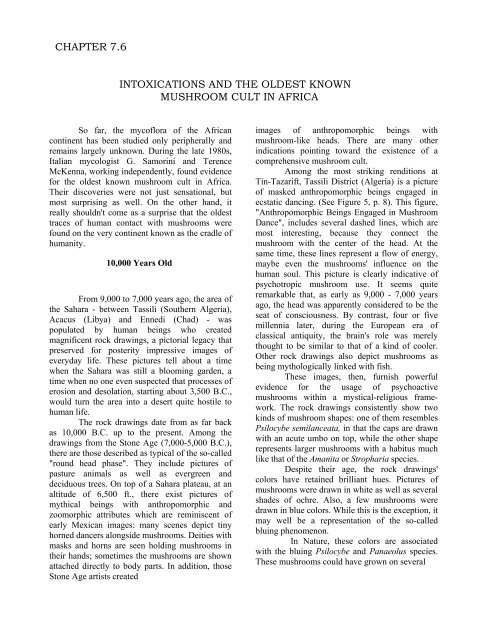Jochen Gartz - Magic Mushrooms Around the ... - preterhuman.net
Jochen Gartz - Magic Mushrooms Around the ... - preterhuman.net
Jochen Gartz - Magic Mushrooms Around the ... - preterhuman.net
You also want an ePaper? Increase the reach of your titles
YUMPU automatically turns print PDFs into web optimized ePapers that Google loves.
CHAPTER 7.6<br />
INTOXICATIONS AND THE OLDEST KNOWN<br />
MUSHROOM CULT IN AFRICA<br />
So far, <strong>the</strong> mycoflora of <strong>the</strong> African<br />
continent has been studied only peripherally and<br />
remains largely unknown. During <strong>the</strong> late 1980s,<br />
Italian mycologist G. Samorini and Terence<br />
McKenna, working independently, found evidence<br />
for <strong>the</strong> oldest known mushroom cult in Africa.<br />
Their discoveries were not just sensational, but<br />
most surprising as well. On <strong>the</strong> o<strong>the</strong>r hand, it<br />
really shouldn't come as a surprise that <strong>the</strong> oldest<br />
traces of human contact with mushrooms were<br />
found on <strong>the</strong> very continent known as <strong>the</strong> cradle of<br />
humanity.<br />
10,000 Years Old<br />
From 9,000 to 7,000 years ago, <strong>the</strong> area of<br />
<strong>the</strong> Sahara - between Tassili (Sou<strong>the</strong>rn Algeria),<br />
Acacus (Libya) and Ennedi (Chad) - was<br />
populated by human beings who created<br />
magnificent rock drawings, a pictorial legacy that<br />
preserved for posterity impressive images of<br />
everyday life. These pictures tell about a time<br />
when <strong>the</strong> Sahara was still a blooming garden, a<br />
time when no one even suspected that processes of<br />
erosion and desolation, starting about 3,500 B.C.,<br />
would turn <strong>the</strong> area into a desert quite hostile to<br />
human life.<br />
The rock drawings date from as far back<br />
as 10,000 B.C. up to <strong>the</strong> present. Among <strong>the</strong><br />
drawings from <strong>the</strong> Stone Age (7,000-5,000 B.C.),<br />
<strong>the</strong>re are those described as typical of <strong>the</strong> so-called<br />
"round head phase". They include pictures of<br />
pasture animals as well as evergreen and<br />
deciduous trees. On top of a Sahara plateau, at an<br />
altitude of 6,500 ft., <strong>the</strong>re exist pictures of<br />
mythical beings with anthropomorphic and<br />
zoomorphic attributes which are reminiscent of<br />
early Mexican images: many scenes depict tiny<br />
horned dancers alongside mushrooms. Deities with<br />
masks and horns are seen holding mushrooms in<br />
<strong>the</strong>ir hands; sometimes <strong>the</strong> mushrooms are shown<br />
attached directly to body parts. In addition, those<br />
Stone Age artists created<br />
images of anthropomorphic beings with<br />
mushroom-like heads. There are many o<strong>the</strong>r<br />
indications pointing toward <strong>the</strong> existence of a<br />
comprehensive mushroom cult.<br />
Among <strong>the</strong> most striking renditions at<br />
Tin-Tazarift, Tassili District (Algeria) is a picture<br />
of masked anthropomorphic beings engaged in<br />
ecstatic dancing. (See Figure 5, p. 8). This figure,<br />
"Anthropomorphic Beings Engaged in Mushroom<br />
Dance", includes several dashed lines, which are<br />
most interesting, because <strong>the</strong>y connect <strong>the</strong><br />
mushroom with <strong>the</strong> center of <strong>the</strong> head. At <strong>the</strong><br />
same time, <strong>the</strong>se lines represent a flow of energy,<br />
maybe even <strong>the</strong> mushrooms' influence on <strong>the</strong><br />
human soul. This picture is clearly indicative of<br />
psychotropic mushroom use. It seems quite<br />
remarkable that, as early as 9,000 - 7,000 years<br />
ago, <strong>the</strong> head was apparently considered to be <strong>the</strong><br />
seat of consciousness. By contrast, four or five<br />
millennia later, during <strong>the</strong> European era of<br />
classical antiquity, <strong>the</strong> brain's role was merely<br />
thought to be similar to that of a kind of cooler.<br />
O<strong>the</strong>r rock drawings also depict mushrooms as<br />
being mythologically linked with fish.<br />
These images, <strong>the</strong>n, furnish powerful<br />
evidence for <strong>the</strong> usage of psychoactive<br />
mushrooms within a mystical-religious framework.<br />
The rock drawings consistently show two<br />
kinds of mushroom shapes: one of <strong>the</strong>m resembles<br />
Psilocybe semilanceata, in that <strong>the</strong> caps are drawn<br />
with an acute umbo on top, while <strong>the</strong> o<strong>the</strong>r shape<br />
represents larger mushrooms with a habitus much<br />
like that of <strong>the</strong> Amanita or Stropharia species.<br />
Despite <strong>the</strong>ir age, <strong>the</strong> rock drawings'<br />
colors have retained brilliant hues. Pictures of<br />
mushrooms were drawn in white as well as several<br />
shades of ochre. Also, a few mushrooms were<br />
drawn in blue colors. While this is <strong>the</strong> exception, it<br />
may well be a representation of <strong>the</strong> so-called<br />
bluing phenomenon.<br />
In Nature, <strong>the</strong>se colors are associated<br />
with <strong>the</strong> bluing Psilocybe and Panaeolus species.<br />
These mushrooms could have grown on several








![The Big Lie 9-11 and Government Complicity in Mass Murder [PDF]](https://img.yumpu.com/50957077/1/190x245/the-big-lie-9-11-and-government-complicity-in-mass-murder-pdf.jpg?quality=85)








